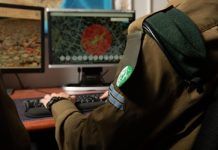University of Warwick researchers have announced the development of a new type of sensor said to be able to detect and identify hidden objects more rapidly than existing technologies. Called ‘Q-Eye’, the invention senses radiation across the spectrum between microwaves and infra-red, known as the Terahertz (THz) region of the spectrum. According to its developers at the University’s physics department it works by detecting the rise in temperature produced when electromagnetic radiation emitted by an object is absorbed by the sensor, even down to the level of very small packets of quantum energy (a single photon).
The patented device involves a thin film of aluminium deposited on top of a silicon layer placed under strain, used to create an electronic cooling (e-cooling) process. The electrons in the silicon layer are so isolated from the silicon lattice they become highly sensitive to incoming radiation. This “e-cooling” process is the secret to Q-Eye sensor’s ability to carry out rapid imaging and material identification the team claims.
What’s more, the device can be made using standard silicon processes, enabling large numbers of detector chips containing designs matched to a particular application to be fabricated on large (300mm) wafers with great uniformity.







